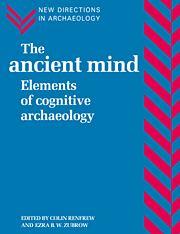Book contents
- Frontmatter
- Contents
- List of figures
- List of tables
- List of contributors
- Preface
- PART I INTRODUCTION
- PART II THE INTERDISCIPLINARY UNDERPINNING
- PART III APPROACHES TO CULT PRACTICE AND TRANSCENDENTAL BELIEF SYSTEMS
- 6 The archaeology of religion
- 7 Ancient Zapotec ritual and religion: an application of the direct historical approach
- 8 The meaning of death: funerary beliefs and the prehistorian
- 9 Prehistoric cognition and the science of archaeology
- PART IV PREHISTORIC CONCEPTIONS OF SPACE AND TIME
- PART V THE MATERIAL BASIS OF COGNITIVE INFERENCE: TECHNOLOGY
- PART VI THE MATERIAL BASIS OF COGNITIVE INFERENCE: WRITING SYSTEMS
- PART VII CONCLUSION
- Index
8 - The meaning of death: funerary beliefs and the prehistorian
Published online by Cambridge University Press: 03 December 2009
- Frontmatter
- Contents
- List of figures
- List of tables
- List of contributors
- Preface
- PART I INTRODUCTION
- PART II THE INTERDISCIPLINARY UNDERPINNING
- PART III APPROACHES TO CULT PRACTICE AND TRANSCENDENTAL BELIEF SYSTEMS
- 6 The archaeology of religion
- 7 Ancient Zapotec ritual and religion: an application of the direct historical approach
- 8 The meaning of death: funerary beliefs and the prehistorian
- 9 Prehistoric cognition and the science of archaeology
- PART IV PREHISTORIC CONCEPTIONS OF SPACE AND TIME
- PART V THE MATERIAL BASIS OF COGNITIVE INFERENCE: TECHNOLOGY
- PART VI THE MATERIAL BASIS OF COGNITIVE INFERENCE: WRITING SYSTEMS
- PART VII CONCLUSION
- Index
Summary
In recent years a number of important studies have endeavoured to address the question of the symbolism embedded in prehistoric funerary structures and practices (Shanks and Tilley 1982; Tilley 1984; Hodder 1984; Morris 1988). This reflects an optimism which is prepared to ignore Ucko's warning, illustrated by a wide range of ethnographic parallels, of the difficulty of interpreting beliefs from burial practices, even at a fairly general level (Ucko 1969). It may indeed be fair to dismiss some of Ucko's reservations as rare exceptions to the general run of human beliefs, but the methodological question remains. How far is it possible to investigate past ideologies and beliefs in the absence of written records?
The answer will, to some extent, depend on the precise meaning we attach to terms such as ‘ideology’ and ‘belief’, since some aspects of past human behaviour are naturally much more accessible to us than others. We may indeed think in terms of a Hawkesian ‘ladder of inference’ (Hawkes 1954), where it is relatively easy to infer the form of treatment given to the dead, but clearly impossible, in the absence of written records, to know the names of deities or the details of myths. Hawkes, however, took a gloomy view:
You can use ethnological data obtained from modern primitives to stimulate your imagination by suggesting the sort of religious institutions and spiritual life your prehistoric peoples may or could have had, but you cannot in this way demonstrate what they did have, and you cannot even hope to unless you can show some real connection between this modern and that prehistoric.
(Hawkes 1954; quoted in Ucko 1969)- Type
- Chapter
- Information
- The Ancient MindElements of Cognitive Archaeology, pp. 75 - 82Publisher: Cambridge University PressPrint publication year: 1994
- 5
- Cited by

